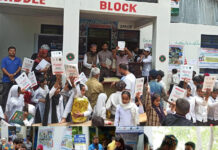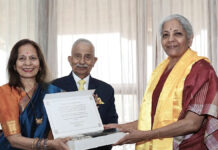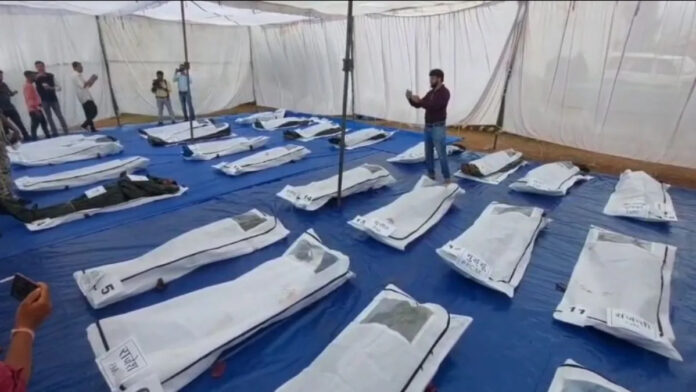AGENCY
NEW DELHI, May 22
In what marks the most decisive blow to Maoist insurgency in nearly four decades of conflict in South Chhattisgarh, security forces achieved an unprecedented success on Wednesday by gunning down Basavaraju, the general secretary of the CPI (Maoist)’s Central Committee. The high-profile Maoist leader was eliminated during a daring encounter in the densely forested Abujhmad region of Bastar, along with his full security detail. A total of 27 Maoists were killed in the operation, making it the largest anti Naxal victory in Bastar’s insurgency history.
Sources suggest that the operation was based on highly specific intelligence inputs derived from a surrendered Maoist, once a personal bodyguard to Basavaraju. These inputs revealed that the top Maoist commander had been frequently shifting locations to evade security dragnet, moving between villages. The breakthrough allowed the force to launch a swift and secretive strike.
The encounter took place when Basavaraju, along with his escort team drawn from PLGA’s elite Platoon No. 7, was trying to relocate to what was assumed to be a safer zone. As forces closed in on the target in the early hours of Wednesday, the Maoists initiated firing. What followed was a fierce gunfight lasting two to three hours, in which all insurgents were neutralised. Basavaraju, whose real name was Mallojula Venugopal, was considered the most strategically important figure in the Maoist hierarchy. Born in the 1960s in Kotabommali, Srikakulam district of Andhra Pradesh, he came from a modest Telugu-speaking family and was driven by ambition from a young age. He earned an engineering degree from the Regional Engineering College in Warangal (now NIT Warangal). As a student, he was associated with the Radical Students Union and was known for his interest in kabaddi and leftist ideology.
After a brief arrest in 1980, he went underground and joined the Naxalite movement. In 1987, he received military training from ex-LTTE cadres in the forests of Bastar. Over the next four decades, he held various leadership roles across Andhra Pradesh and Chhattisgarh. In 2004, he was appointed head of the Maoists’ Military Commission, and in 2018, following the retirement of General Secretary Ganapathi (Muppala Lakshmana Rao), he rose to the organisation’s top post. Basavaraju’s military leadership was legendary among Maoist ranks. He is credited with training Hidma, the infamous commander of PLGA Battalion 1, and was instrumental in the formation of the Maoists’ most brutal strike units. He remained a central figure behind major attacks including the 2010 Tadmetla massacre in Sukma, where 76 CRPF personnel were ambushed and killed, and the 2013 Jheeram Ghati attack that killed several top Chhattisgarh Congress leaders. Investigations into both attacks revealed Basavaraju’s direct involvement in their planning and execution. Security officials believed no major Maoist strike in Bastar could occur without his clearance.
Highly evasive and mobile, Basavaraju was known to operate under at least 13 aliases, including Sanvalla Keshav Rao, Krishna, Vinay, Prakash, Vijay, Keshav, BR, Umesh, Rajudharapu Narasimha Reddy, and simply Narasimha. This allowed him to traverse vast stretches of terrain across state borders, sometimes appearing in West Bengal one day and Abujhmad the next. His role as the strategic and organisational bridge between the Maoists’ northern and southern zones made him irreplaceable in the group’s structure.
Alongside Basavaraju, the Wednesday encounter also resulted in the death of several high ranking Maoist operatives. Among them was Yasna alias Naveen, who carried a bounty of Rs 25 lakh. Intelligence sources also confirmed the elimination of Madhu, a senior figure in the Dandakaranya Special Zonal Committee, and two influential members from the Telugu cadre. All 27 bodies were recovered and transported to Narayanpur for forensic examination.
The operation marked a strategic shift in force deployment. For the first time in a major anti Naxal mission, the task was assigned exclusively to District Reserve Guard (DRG) personnel from Narayanpur, Kondagaon, Bijapur, and Dantewada. Over 1,000 jawans participated in the operation. The decision to deploy only DRG units was deliberate, based on the force’s deep familiarity with Bastar’s topography and tribal communities, which ensured high mobility and seamless coordination. Traditionally, such operations involve mixed forces, which can lead to operational complexities. According to officers involved in the planning, the DRG’s intimate knowledge of the terrain made it the ideal choice for this sensitive mission.
A senior police official, detailing the execution of the operation, said that following specific intelligence inputs regarding the presence of Maoists in villages within the Maad region, combined DRG units were mobilised from four districts. As the forces advanced towards the target area, around 50 Maoists opened fire from concealed positions within the dense forest. A prolonged and intense exchange of gunfire ensued, ultimately culminating in the elimination of all hostile elements, including Basavaraju.
In the aftermath of this success, forces across Bastar remain on high alert. Maoist regrouping and retaliatory actions are being closely monitored, and Central agencies have issued clear directives to maintain heightened vigilance. Officials have reported noticeable movements and unease within Maoist ranks following the loss of their supreme commander.
Basavaraju’s death is expected to cause irreversible disruption within the Maoist command chain. Though 12 senior Central Committee members still remain active, none possess the strategic foresight, combat expertise, and unifying charisma that Basavaraju brought to the table. His absence leaves the CPI (Maoist) without a clear successor capable of commanding respect across both the northern and southern insurgent belts. His role in coordinating attacks, managing supplies, and rallying ground level cadre was vital to the operational continuity of the movement.
Security analysts believe that this is the beginning of the end for Maoist insurgency in Bastar. Basavaraju, who operated with surgical precision and brutal efficiency for over three decades, was the symbol of Red Terror in Chhattisgarh and Andhra Pradesh. His elimination by the same local tribal commandos who once lived under his shadow marks a historic reversal in the region’s power dynamics. This encounter is not just a tactical milestone but a psychological one, it shatters the myth of Maoist invincibility in the red corridor. As senior journalist, Rajat Vajpayee put it, “Basavaraju’s death is not just a kill, it is the collapse of a doctrine.”



























